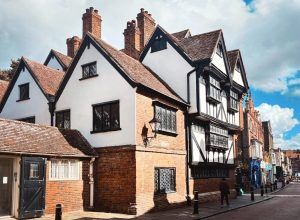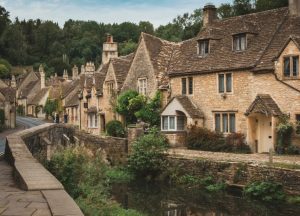
York is England’s best-preserved medieval city, a place where history doesn’t whisper – it bellows from every stone and timber. I’ve yet to meet anyone who hasn’t been taken by its charm, and I’m convinced no trip to the North is complete without stepping into this living time capsule.
A city shaped by Romans, sacked by Vikings, raised by Normans, and reworked by industrious Victorians – York has been a battleground, a religious flashpoint, and a stubborn northern outpost that’s seen more war, plague, and glory than a Steven Spielberg film.
You don’t come here for afternoon tea at Betty’s (though you can). You come for stone under your boots, centuries in your face, and the stories hiding behind crooked doors. If England had a soul, York might be it. Tangled, poetic, and deliciously haunted.

Must-see places and things to do in York
Whether you’re visiting York for just a day or arriving for a long weekend, there’s no shortage of attractions ranging from the historical to the downright quirky. To help you plan before you go, here’s my list of the best things to do in York – arguably North England’s most well-loved city.
I grew up in Yorkshire, and I’ve been to York a million times, okay, not a million, but somewhere close to a hundred, so I think I’m in a good position to show you around the city.
1. Discover the medieval city gates

The city gates of York – locally known as bars – is like stepping through a time-worn threshold into centuries of history, battle, and pageantry. These gates once controlled access to the walled city and are now iconic entry points to its medieval soul.
Micklegate Bar, perhaps the most famous, was the ceremonial gate for monarchs entering the city – but it also served a darker role, with traitors’ heads displayed on spikes above its arch. Bootham Bar (pictured), guarding the route to the Minster, blends Roman foundations with later Norman additions. Monk Bar, the tallest and most fortified, still houses a portcullis and today contains a museum dedicated to Richard III. Walmgate Bar is the only surviving gate with its original barbican, complete with timber-framed Tudor housing above the arch.
Each of these gates isn’t just an architectural relic – they’re living reminders of York’s strategic importance, its military might, and its flair for spectacle. Walk through them, and you’re following in the footsteps of knights, kings, rebels, and pilgrims.
2. Visit York Minster

York Minster isn’t just a cathedral. It’s a testament to faith, power, and sheer architectural obsession. It took 250 years to build which is hardly a surprise given the immense attention to detail. The stained glass – some of the oldest and most intricate in Europe – still glows with medieval colour. Beneath it lie the ruins of a Roman fortress and an Anglo-Saxon church that’s now a museum.
Recommended: If you can, attend Evensong at 5.30pm Tue – Sat and 4pm Sun. The choir lifts voices into that vast vaulted ceiling. The sound, pitch and harmonies are heavenly, even non-believers might just start believing that angels do exist.
On a budget? The entry is expensive at £20 and an extra £6 to climb the tower. However, the price of the ticket is valid for one year. If you live in the UK, and plan to visit York again, be sure to hold onto your ticket. If you want to save some money, you can attend a Sunday service morning for free. These are typically held at 10 am and 11 am. See their website for more details.
3. Wander down the Shambles


They say this was once the street of butchers, and the blood flowed down the cobbled gutters. Today, it’s filled with delightful fudge shops, vintage bookstores, and tourists hunting for a bit of Potter-themed nostalgia.
Be sure to look up – the overhanging timbered buildings lean in like conspirators. The oldest ones date to the 14th century. Walk it early in the morning or late at night, when the crowds are gone, and you’ll feel the bones of York breathing beneath the surface. Venture down the narrow snickleways that lead out like tree branches to the market square.
4. Walk the city walls

York’s ancient walls are the longest and best preserved in England. Originally built by the Romans, expanded by medieval kings, and patched up ever since, these stone ramparts stretch over two miles and enclose the old city like a stubborn hug from history.
Walk the full circuit or just a section if you’re squeezed for time. You’ll pass through Roman gates, over watchtowers, and by back gardens filled with laundry and wildflowers.
5. Drink in a pub that’s older than America


York does pubs like nowhere else. They’re not modern, shiny drinking establishments – they’re creaky higgledy-piggledy homes to ale, soaked in centuries of spilled beer, pork scratchings and belly laughs.
Try The Black Swan, a 15th-century inn with crooked beams and a fire that’s been burning longer than most governments have stood. Or Ye Olde Starre Inne, which has operated since 1644, its sign hanging across the street like a war banner. Sit down, order a pint, and you’ll be drinking with the dead.
There’s also Guy Fawkes Inn where the famous gunpowder plot conspirator was born. For those of you who are not British and might not know – Guy Fawkes is an infamous figure in British history and the reason we celebrate Bonfire Night every year on 5th November. In other news – the pub is also famous for their steak and ale pie.
Honestly, there are so many more pubs, too many to name. My best advice is just to wander inside and soak up the cosy atmosphere. I should warn you – it’s easy to forget the time, so squeeze in some sightseeing before you grab a pint!
6. Walk along or ride across the River Ouse


The River Ouse has been the city’s lifeblood (and its occasional enemy) for over a thousand years. The Romans used it for trade, the Vikings sailed up it to conquer, and while things are less dramatic in York these days, the river is still prone to flooding.
On a calm day, join a riverboat tour and drift past medieval guildhalls and stone bridges while your guide entertains you will stories and historical titbits. Smaller boats might also lead you down the River Foss (pictured left), a smaller branch of the River Ouse that runs north east of the city.
While one can only hope for sunshine for such an activity, you might want to pack a waterproof jacket. If we know anything about British weather, we know that rain is guaranteed.
7. Climb Clifford’s Tower


Clifford’s Tower looked enormous to me as a child. The way it loomed over York from the top of a big mountain looked kind of magical and prehistoric. And now? Well, as an adult with a greater grasp of size and scale it looks much smaller. It doesn’t loom but rather perches on a perfectly-shaped grassy mount. Nonetheless, it still has an imposing presence.
Built by the Normans, torched by rebels and ransacked by Vikings, Clifford Tower is almost all that remains of York Castle built by William the Conqueror. As it fell into despair it served as a prison and a royal mint in its time. It has seen and experienced a lot to say the least.
After being closed for as long as I can remember, since 2022 you can now actually go inside. It’s free for National Heritage members, and otherwise £10 to enter. If you’re on a budget – don’t worry – the best part is the views. It’s free to climb the stairs and walk around the top of the mound to enjoy city views: rooftops, spires, the slow bend of the River Ouse.
8. Search for the black cats


York is a city of walls, ghosts, and churches – layers of conquest and conviction stacked like geological time. But look up and you’ll see something else: cats. Dozens of them. Carved in wood. Cast in metal. Perched on ledges, crouched on cornices, frozen mid-prowl on rooftops. Silent, still, watching.
This is the York Cat Trail – a self-guided scavenger hunt through the old city, following the odd tradition of feline figures placed on buildings. Some are sleek and graceful. Others look like they were designed by someone who’d only heard about cats in theory. All of them have stories. Some were meant to ward off rats, others simply to amuse, a wink from one era to the next.
The route is informal. You start at The Cat Gallery on Low Petergate, pick up a free map (or follow this online guide), and head out into the maze. Past the towering presence of the Minster, down hidden alleys, along medieval walls. All the while, scanning rooftops like some deranged naturalist hoping to catch a glimpse of a beast made of bronze. They don’t meow. They don’t move. But they remind you to slow down and look up. It’s the perfect activity for families or those who just enjoy quirky things to do.
9. Visit York Castle Museum
This isn’t a sterile gallery with glass boxes- it’s an interesting and rather quirky museum that takes you on a journey back in time. You can stroll down a recreated Victorian street, peek into a Georgian prison, and see what life was like for the poor, the desperate, and the just plain unlucky.
Set inside the former prison where the infamous highwayman Dick Turpin spent his final days, the museum dives headfirst into social history. You leave with lots stories in your head and feeling rather lucky that you’re living in an age with a few more creature comforts!
10. Hunt for snickelways

York is threaded with snickelways – narrow alleys that twist behind buildings, between courtyards, and into bits of the city most tourists never see. With names like Mad Alice Lane and Nether Hornpot Lane, these passages are part riddle, part invitation. Some date back to the Middle Ages. Follow them not with a map, but with curiosity. You’ll find hidden pubs, secret gardens, and stories scribbled into walls.
If you really want to explore these snickelways in more detail, join a snickelways story and walking tour. With an expect guide, you’ll discover what went down in these narrow, secret alleyways all those years ago.
11. Explore Jorvik Viking Centre
Yes, it’s touristy but there’s nothing else really like it. This place brings the viking era to life.
Yes, there are animatronic Norsemen. But if you can handle the smell of simulated Viking latrines, the Jorvik Centre offers one of the most vivid glimpses into York’s Viking past. Built directly over a major archaeological dig, it recreates 10th-century York with astonishing detail.
These weren’t cartoon villains, they were traders, settlers, craftspeople. It’s weird, immersive, and memorable. Children especially love this place – I did when I was little! I’ve not been since starting this blog, but one day I’ll go back.
12. Have a proper roast at a local carvery
You haven’t really been to Yorkshire until you’ve filled your plate with roast beef, crispy potatoes, carrots dripping with butter, and a Yorkshire pudding big enough to sail in. Go to The Hole in the Wall or find a no-frills Sunday carvery where locals eat. It’s hearty, messy, glorious food – the kind that sticks to your ribs and reminds you why the north endures.
13. Or indulge in international cuisine


Every time I visit York, the number of establishments offering international cuisine are growing. My favourite? Los Moros which serves up delicious North African plates.
Enjoy mouthfuls of creamy hummus sprinkled with harissa and fluffy chickpeas, grilled octopus smothered in a pomegranate molasses glaze, and beef cheeks Tanjia served with cumin gouda mash. The star of the show? The Algerian cassoulet will leave you wanting to lick the plate (I confess to doing this. Eating is more fun without table manners, right?). I thought nothing would beat the cassoulets I demolished in Toulouse, but I was wrong.
14. Castle Howard

Located just a 20 minutes’ drive from York, Castle Howard is one of Britain’s most beautiful stately homes. Tucked away in pristine countryside, this 18th-century masterpiece isn’t just a building – it’s a stage set for aristocratic ambition. Those who visit enter a world of baroque design crafted by power, privilege, and ambition.
Yes, the whole place is incredibly excessive – minimalism it certainly is not – but the combination of architecture and breathtaking nature is something to be seen.
Designed by John Vanbrugh, the same dramatist-turned-architect behind Blenheim Palace, Castle Howard took over a hundred years to complete. You’ll wander through grand halls dripping with frescoes, gilded ceilings, Roman statues, and family portraits that stare at you like you owe them rent.
The landscaped grounds roll on for miles. It’s filled with temples, fountains, lakes, even a ruined pyramid each more theatrical than the last. And if it feels familiar, you probably recognise it from the big screen. Castle Howard has played Brideshead more than once among many other period dramas.
Are you planning a trip to York?
You might also like to visit Harrogate, a beautiful spa town in North Yorkshire located around 40 minutes’ drive from York. For more information, take a look at these things do in Harrogate and the surrounding area.
Want to see more of medieval England? Check out these cities on the blog:









